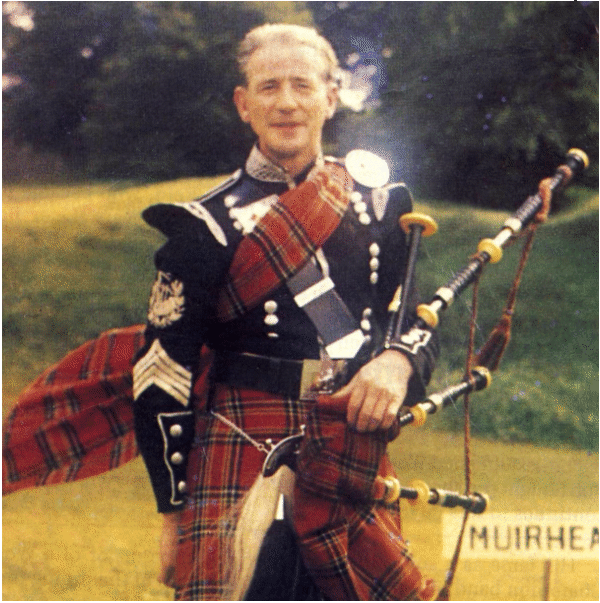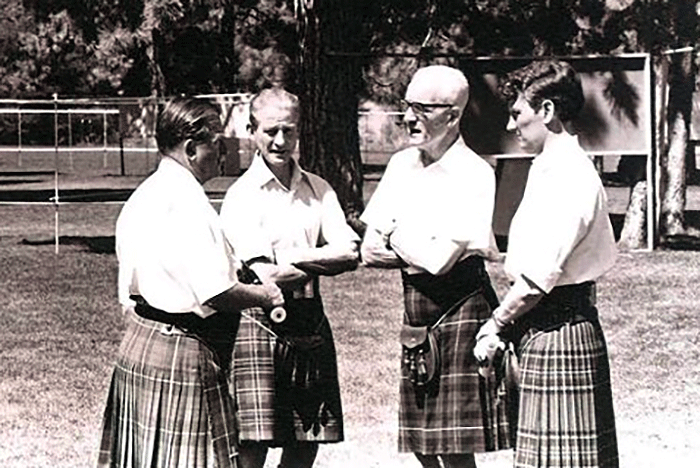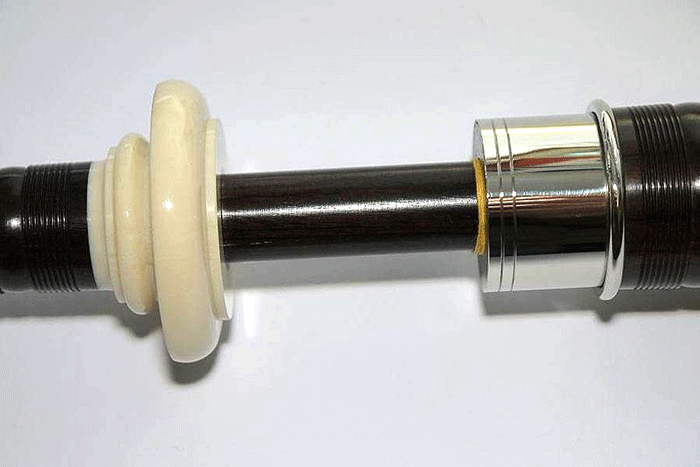
We are very grateful to Jim Barrie in western Canada for forwarding these recordings of Bob Hardie playing at an impromptu recital at the Coeur d’Alene Summer School in Idaho in the early 1970s.
Bob went there on several occasions at the invite of the Principal Col. John McEwing and taught with the likes of Andrew Wright, John Wilson, Toronto, John MacAskill, and on one occasion, James Campbell.
Bob is pictured above in the Muirhead & Sons uniform, probably at Cowal, and the pipes pictured are almost certainly the set played on the recordings.
By the Editor
We would be delighted to hear from anyone who was at the school and who heard Bob play.
We begin with some Gaelic airs then a couple of 6/8s. A name for the second 6/8 would be welcome. The first is Jean Mauchline.

The final excerpt we have is the piobaireachd, Corrienessan’s Salute. This was the tune with which Bob won the Oban Gold Medal in 1947 (and which I played at his funeral).
At the time of these recordings he was still Pipe Major of the Muirhead & Sons band, but its great years of success were behind it (they had won the Worlds from 1965-1969). He continued with Muirheads until it folded in 1978.
It was whilst playing football at Coeur d’Alene that Bob Hardie sustained a finger injury. This led to a contracture in his right hand which surgery failed to cure.
Apart from the fine piobaireachd playing in the recording, pipers today should listen out for the crunluath movement. It features the ‘redundant’ A as taught to Bob by his tutor Robert Reid. Notice how the extra gracenote does not affect the rhythm of the movement but gives it a fulsome, rippling quality.
Bob always taught this way of playing the crunluath – if you missed one gracenote you still had the usual seven. Listen also for the slight pause or ‘hang’ before the cadences in the taorluath and crunluath singlings, a characteristic of the so-called ‘Cameron’ school.
The set of pipes Bob played were ‘bits and pieces’, as he described them, gathered up from his RG Hardie workshop floor, plus sheepskin bag, cane reeds and Hardie chanter.
He never used tape on his chanter but blew sharp or flat to correct notes as required. ‘Everything is in the blowing’, he used to say.
I hope readers will enjoy this tune as much as I did and thanks again to Jim Barrie for sharing it with us.
- For more historic piping recordings, check out our audio archive here.

















I played in the Muirheads drum corps when Bob Hardie was Pipe Major. Rab Turner was leading tip and Peter Anderson and Ian Mcskimming and myself were side drummers. It was a fantastic band, full of quality and no shortage of characters. Bob Hardie was a fantastic Pipe Major. He didn’t say a lot during practice sessions, normally a look was enough. Wonderful memories.
Re tape and Bob Hardie.
The late great Hugh McInnes and I played in Muirheads around 1969/70 and we were fanatical about a true sound from our chanters so of course used black tape. At band practice Bob would pull it off and get very annoyed as it stuck to his fingers! Also he carried about a box of pipe chanters and would sometimes get a chanter to suit a reed rather than the other way round!
What a wonderful man!
The mention that Bob Hardie never used tape on his chanter, makes me ask the question ‘when did the use of black electrical tape come into use ?’ I don’t recall its being used when I first took up the pipes in 1965 and played with the 57th RAMC (T.A .) under P/Ms Bob Hill and Gordon Speirs, nor in my years with B.Cal. (1978 – 1986) under P/Ms Bob Richardson and Harry McNulty. Bob Hardie’s son, Jim, also played with B.Cal. I think I began using tape around 1998, when I joined the Surrey Pipe Band under P/M Roger Huth.
Is this the same RG Hardie, the founder and craftsman of the pipe making firm? I assume it is since it was mentioned that his pipes were bits and pieces he picked from the floor in his workshop. That’s how you know a fine piper and a fine pipe maker who crafts an exceptional instrument, if they can pick the scraps from the floor and bust out a fine tune from a scrappy set of floor pipes.